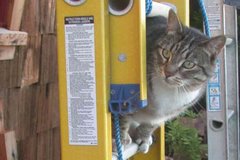i heard "porpoises on the port side" on the loudspeaker and i ran for
my camera. i went out on the fan tail (the stern of the main deck) and
looked to port and saw ~6 jumping in unison... did not have my camera,
but i ran around up a deck and got ready. as i was doing so, casey
(computer lab tech from UW) yelled, "look a whale." we saw a beautiful
humpback swimming alongside for a few seconds...
then i looked around and saw many many whale spouts and hundreds of
dolphins. my zoom is small on my camera, so i got ready for ones that
would swim closer to the ship.... after about 150 shots, i got a dozen
good pics. so beautiful. these are pacific white sided dolphins
http://en.wikipedia.org/wiki/Pacific_white-sided_dolphin
this is the best close up of the lot, with two looking up at me (lol).













